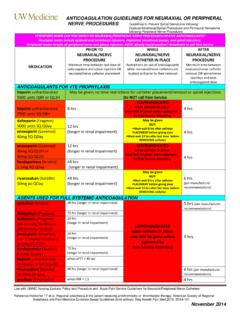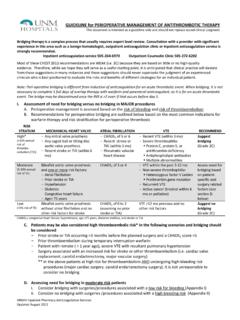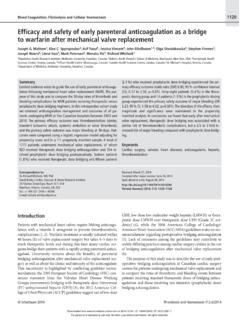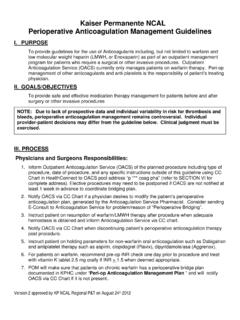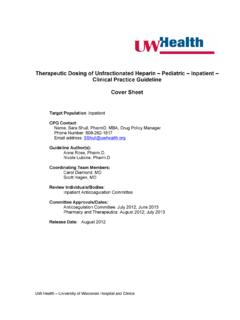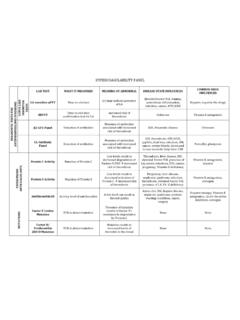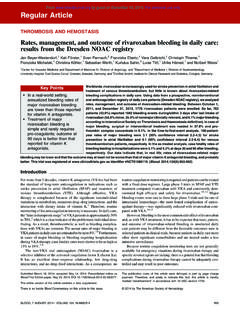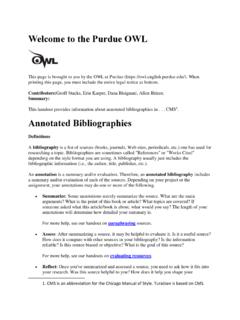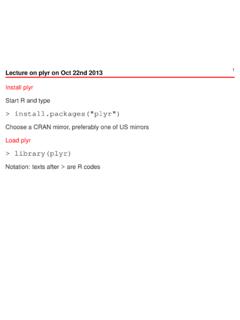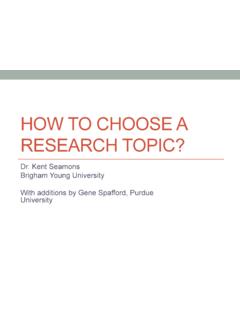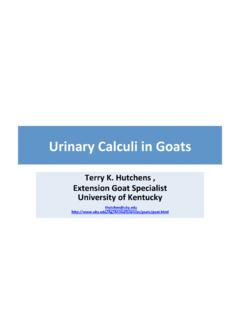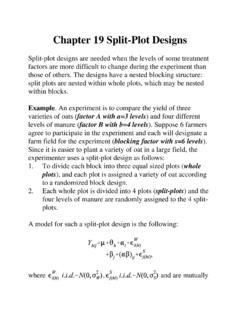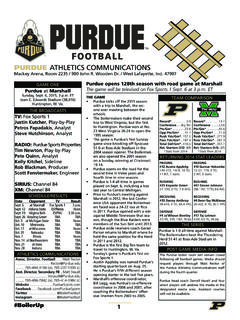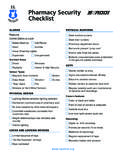Transcription of Toolkit read only - AC Forum
1 ANTICOAGULANT. Toolkit . Reducing Adverse Drug Events &. Potential Adverse Drug Events with Unfractionated Heparin, Low Molecular Weight Heparins and Warfarin ANTICOAGULANT Toolkit . Reducing Adverse Drug Events & Potential Adverse Drug Events with Unfractionated Heparin, Low Molecular Weight Heparins and Warfarin Developed by Purdue University PharmaTAP in collaboration with the Indiana Patient Safety Center (IPSC), Indiana Hospital Association (IHA) and VHA Central. Copyright 2008 Purdue University PharmaTAP. All Rights Reserved. Permission to use, copy, modify, and distribute all or portions of this Toolkit without fee and without written agreement is hereby granted by Purdue University PharmaTAP. Purdue University PharmaTAP, 6640 Intech Blvd., Suite 120, Indianapolis, IN 46278 2012. ii |. Acknowledgements Thank you to the many individuals who have contributed their time, expertise and creativity for the development of this Toolkit .
2 Their generosity has made this Toolkit possible. Specifically, we'd like to thank: Carol Birk, , Betsy Lee, , Gloria Sachdev, Director Director Clinical Assistant Professor Purdue University, PharmaTAP Indiana Patient Safety Center Pharmacy Practice, Purdue Indianapolis, IN Indianapolis, IN University School of Pharmacy and Pharmaceutical Sciences Frank Federico Steve Meisel, West Lafayette, IN Content Director Director, Medication Safety Institute for Healthcare Fairview Health Services Ellen Schellhase, Improvement Minneapolis, MN Assistant Professor Cambridge, MA Pharmacy Practice, Purdue Erin Moore, University School of Pharmacy and Jan Kirsch, , , Communications Specialist, Pharmaceutical Sciences Senior Director Regenstrief Center for Healthcare West Lafayette, IN Performance Improvement, Engineering at Purdue University VHA Central West Lafayette, IN Indianapolis, IN Tool Kit Resource Contributors Kristi Williams, Brian Wolfe.
3 Pharmacy Clinical Services Manager Clinical Pharmacy Coordinator Union Hospital Ball Memorial Hospital Terre Haute, IN Muncie, IN Additionally, thank you to the Institute for Healthcare Improvement (IHI) and VHA Central for their materials. iii | A n t i c o a g u l a n t T o o l k i t Table of Contents Chapter 1: Introduction .. 1. Chapter 1 Resources .. 5 Chapter 2: Self 10. Chapter 2 Resources .. 12 Chapter 3: Improving Anticoagulant Processes .. 53. Chapter 3 Resources .. 60 Chapter 4: Measuring Performance .. 70. Chapter 4 Resources .. 73 Chapter 5: Spreading and Sustaining Improvement .. 77. Chapter 5 Resources .. 79 Chapter 6: Additional References .. 82. iv |. Ch t 1 I t d ti 1|Anticoagulant Toolkit Introduction Anticoagulants, such as Unfractionated Heparin, Low Molecular Weight Heparins, and Warfarin, are considered high risk drugs for adverse drug events (ADE)1, defined by the Agency for Healthcare Research and Quality (AHRQ) as expected adverse drug reactions (or "side effects") and events due to error2.
4 Preventable adverse drug events are associated with 1 of 5 injuries or deaths and are a result of poorly designed systems, which often lack independent redundancies3. Numerous studies describe the high risks associated with use of anticoagulants. As a drug category, anticoagulants are one of the top five drug types associated with patient safety incidents4 Heparin ranks 3rd in reported products involved in harmful errors. Warfarin ranks 6th and enoxaparin ranks 9th5 of medication errors reported in a hospital were due to anticoagulants. Furthermore, of these required medication intervention6 Warfarin and insulin caused an estimated one in every seven adverse drug events treated in emergency departments, and more than a quarter of all hospitalizations7 Insulin, Warfarin, and digoxin (all narrow therapeutic index medications) were responsible for one in every three adverse drug events treated in an emergency department in patients 65 years and older7 of preventable adverse drug events in a teaching hospital involved anticoagulants.
5 This was double the amount caused by any other medication8 Anticoagulants were responsible for 121 of the 1,523 adverse drug events, a third of which were preventable9 Anticoagulants are included on the Institute for Safe Medication Practice's (ISMP) high alert medication list due to the significant risk of causing life threatening bleeding or thrombosis if the appropriate safe practices are not in place. The Institute for Healthcare Improvement's (IHI) Save 5 Million Lives from Harm campaign has focused in part on harm associated with the use of anticoagulants10. This high risk is due to the complexity of administering this therapy: Selecting the appropriate agent and determining the appropriate dose, Individual patient variability in response to therapy, Timing of and use of the appropriate laboratory measures to monitor response, Proper adjustment of dose based upon the laboratory parameters and/or clinical response, The transition of patients from Heparin therapy to Warfarin, Ensuring patient education and compliance, Use of these agents in a variety of settings, by various practitioners, and within differing patient populations, and Interdisciplinary coordination needed between lab, pharmacy, nursing, medical staff, and dietary.
6 2|Chapter 1: Introduction TABLE 1. Common Risks and Safe Practices Associated with Anticoagulants ISMP Medication Safety Alert, January 11, 2007, Volume 12 Issue 1. Common Risks Safe Practices to Reduce or Eliminate Adverse Drug Events Duplicate or concurrent therapy Avoid reliance on memory. Accidental stoppage of therapy - Use protocols/checklists Look-alike vials or syringes - Automate Look-alike names - Develop built-in reminders Dosing errors Simplify tasks. Calculation errors - Decrease steps in the process Monitoring problems - Decrease number of staff involved in the process Food and drug interactions - Reduce need for calculations Spinal hematoma Reduce or eliminate handoffs. Adverse drug reactions Standardize. Confusion between insulin and Heparin; - Develop practice guidelines, order sets, and pathways between LMWHs and UFH. Use constraints and forcing functions. - Ensure use of required computer fields - Remove outdated forms - Utilize free flow pump protection Improve access to information.
7 - Ensure that up-to-date, accurate information is available when needed Use redundancy. - Create double checks at critical steps in the process Provide adequate training. - Use drills, practice, simulation Manage fatigue. - Offer reasonable work schedules - Ensure adequate staff Design useful, clear, concise policies. The Solution Adverse drug events associated with anticoagulants can be reduced by implementing recognized safe practices in high risk areas, redesigning care processes, partnering with patients and families, and maximizing communications within and across the care continuum. Table 1 outlines common risks and suggested safe practices to reduce or eliminate risks that could lead to adverse drug events. The Institute for Healthcare Improvement's Getting Started Kit entitled Prevent Harm from High Alert Medications: How to Guide lists safe practices specific to Heparin and Warfarin use in inpatient and outpatient The ISMP, whose goal is to educate the healthcare community about safe medication practices, featured anticoagulants in their January 2007 Medication Safety Alert11 which listed risks associated with anticoagulants and recommended safety improvements.
8 3| Anticoagulant Toolkit Additional evidence based support for safe practices with anticoagulants includes the Seventh American College of Chest Physicians (ACCP) Conference on Antithrombotic and Thrombolytic Therapy: Evidence Based Guidelines. Published on a periodic basis, the CHEST Guidelines are well referenced, provide graded recommendations, and cover a variety of different anticoagulant indications and clinical practice The Joint Commission emphasizes and promotes safe use of medications throughout its Standards and National Patient Safety Goals (NPSGs). National Patient Safety Goal (NPSG) 3E was developed with a specific focus on safe use of anticoagulants13 in hospital and ambulatory settings that provide anticoagulant therapy. The Joint Commission established a one year implementation timeline for planning, development and testing changes to meet the intent of the goal. Following this one year transition it is expected that compliance includes continued evaluation of the anticoagulation use processes for Unfractionated Heparins, Low Molecular Weight Heparins (LMWH), and Warfarin.
9 Compliance with the goal is based on review of documents ( patient records, policies and procedures and performance monitors), interviews with patients and staff, and direct observation of processes. Joint Commission National Patient Safety Goal 3E. Reduce the likelihood of patient harm associated with the use of In this Toolkit This anticoagulant Toolkit is intended for use by healthcare providers and institutions to provide effective and safe anticoagulation therapy in all care settings. The Toolkit consists of six chapters designed to offer information and solutions to improve anticoagulant practices. Chapter 1 serves as an introduction to the problems associated with anticoagulants and describes support for evaluating and improving the medication process for anticoagulant management. Chapter 2 is a resource for evaluation and assessment of safe medication practices for anticoagulation. Example tools have been included to assist institutions in developing their own resources for safe anticoagulant use.
10 Chapters 3, 4, and 5 outline strategies for implementing change. Chapter 6 contains additional resources for further knowledge regarding anticoagulation. The following model of care is used throughout the Toolkit and is intended to assist organizations with identification and self assessment of safe practices by specific care environment. Inpatient Transition Outpatie al nt Includes a variety of providers Includes providers from both in Includes a provider(s) responsible (physicians, pharmacists, nurses, patient and out patient settings. for continued and long term care of dieticians) who provide care related Focus is two fold: (1) preparing a patients receiving anticoagulants. to the utilization of anticoagulants. patient for continued care with out patient providers (2) establishing a source of outpatient care. Communication is a key aspect. 4|Chapter 1: Introduction References 1. 2. For example, a serious allergic reaction to penicillin in a patient with no prior history is an ADE, and so is the same reaction in a patient who does have a known allergy history but receives penicillin due to a prescribing oversight.
